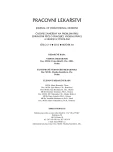System enzyme therapy as a possibility of conservative treatment of the carpal tunnel syndrome – a pilot study
Authors:
M. Nakládalová 1; B. Matúsová 2; P. Smolková 1; J. Holá 1
Authors‘ workplace:
Klinika pracovního a preventivního lékařství LF UP a FN Olomouc, přednostka doc. MUDr. Marie Nakládalová, Ph. D.
1; Centrum pracovního lékařství, s. r. o., Šumperk, vedoucí pracoviště MUDr. Blanka Matúsová
2
Published in:
Pracov. Lék., 64, 2012, No. 2-3, s. 99-102.
Category:
Original Papers
Overview
In this presented report female patients suffering from carpal tunnel syndromes were examined. The disorders were detected during the preventive occupational examinations. Median nerve lesions were detected 11 times in 6 electro-winders (risk of the long-term one-sided overloading, category No. 3) with electromyographic examination. Distinct subjective symptoms relief occurred after 6 weeks of treatment with Wobenzym in most cases. During a control examination 6 weeks after the cessation of treatment with Wobenzym the healing effect lasted. The electromyographic examination after 6 weeks of treatment confirmed the distal motor latency improvement in 8 out of 9 cases. 6 weeks after ceasing the treatment the improvement of the distal motor latency lasted in 7 out of 9 cases. Changes in the velocity of sensitive conduction were not unambiguous. On the basis of these and previously documented experiences a systemic therapy may be considered as a therapeutic modality extending the list of conservative treatment of the carpal tunnel syndrome methods or as a component of preventive beneficiary programs. However, verification in a more extensive study is desirable.
Key words:
carpal tunnel – electromyography examination – Wobenzym – systemic enzyme therapy
Sources
1. Souhrn údajů o přípravku Wobenzym, Dostupný na: http://www.sukl.cz/download/spc/SPC12629.pdf.
2. Věstník MZ 2003, částka 10, Metodické opatření. Stanovení nejméně středního stupně závažnosti izolovaného syndromu karpálního tunelu. Dostupný na: http://www.mzcr.cz/ Legislativa/dokumenty/vestnik_3661_1782_11.html.
3. DESSER, L., HOLOMÁŇNOVÁ, D., ZAVADOVÁ, E. et al. Oral therapy with proteolytic enzymes decreases excessive TGF‑beta levels in human blood. Cancer Chemother. Pharmacol., 2001, 47, Suppl: S10-5.
4. EHLER, E., AMBLER, Z. Mononeuropatie – trendy soudobé neurologie a neurochirurgie. Sv. 3, Praha: Galén, 2002.
5. ETTEMA, A. M., AMADIO, P. C., ZHAO, C. et al. A histological and immunohistochemical study of the subsynovial connective tissue in idiopathic carpal tunnel syndrome. J. Bone Joint Surg. Am., 2004, 86-A, 7, s. 1458–1466.
6. HONZÍKOVÁ, M., NAKLÁDALOVÁ, M., HOLÁ, J. et al. Efekt systémové enzymoterapie u syndromu karpálního tunelu. Pracov. Lék., 62, 2010, 3, s. 132.
7. HUISSTEDE, B. M., HOOGVLIET, P., RANDSDORP, M. S. et al. Carpal tunnel syndrome. Part I: Effectiveness of nonsurgical treatmens-a systematic review. Arch. Phys. Med. Rehabil., 2010, 91, s. 981–1004.
8. JAROŠOVÁ, H. Mimokloubní revmatismus. Practicus, 2010, č. 8, s. 24–32
9. JEZDÍNSKÝ, J. Systémová enzymoterapie. In Lincová D., Farghali H., eds. Základní a aplikovaná farmakologie. 2. vydání, Praha: Galén, 2007; s. 606–611.
10. KAMENÍČEK, V., HOLAŇ, P., FRANĚK, P. Systémová enzymoterapie v léčbě a profylaxi potraumatických a pooperačních otoků. Acta Chir. Ortoped. et Traum. Čech., 2001, č. 1, s. 45–49.
11. KLEIN, G., KULLICH, W., BRUGGER, A. Phlogenzym in der Behandlung der Periarthropatia humeroscapularis tendopathica simplex. Arzt und Praxis, 1997, č. 51 (781), s. 879–885
12. KLEIN, G., KULLICH, W., SCHNITKER, J. et al. Efficacy and tolerance of an oral enzyme combination in painful osteoarthritis of the hip. A double-blind, randomised study comparing oral enzymes with non-steroidal anti-inflammatory drugs. Clin. Exp. Rheumatol., 2006, 24, č. 1, s. 25–30.
13. LAUER, D., MÜLLER, R., COTT, C. et al. Modulation of growth factor binding properties of alpha2-macroglobulin by enzyme therapy. Cancer Chemother. Pharmacol., 2001, 47 Suppl: S4-9.
14. MICHALČÍK, P. Možnosti neinvazivní rehabilitační terapie úžinových syndromů horní končetiny. Rehabilitace a fyzikální lékařství, 2010, 17, s. 143–149.
15. NEUMAYER. C., FUGL, A., NANOBASHVILI, J. et al. Combined enzymatic and antioxidative treatment reduces ischemia-reperfusion injury in rabbit skeletal muscle. J. Surg. Res., 2006, 133, 2, s. 150–158.
16. OLEJÁR, T., POUČKOVÁ, P., ZADINOVÁ, M. Systémová enzymoterapie ve sportovním lékařství – obecné principy, indikace a klinické zkušenosti. Med. Sport. Bohem. Slov., 1998, 7, č. 4, s. 113–115.
17. RAHN, H. D. Begleitende Therapie durch hydrolytische Enzyme bei arthroskopischer Meniskuresektion. Prakt. Sport-Traumatologie und Sportmedizin, 1994, 10, č. 3, s. 123–127.
18. SUD, V., FREELAND, A. E. Biochemistry of carpal tunnel syndrome. Microsurgery, 2005, 25, 1, s. 44–46.
19. SZCZURKO, O., COOLEY, K., MILLS, E. J. et al. Naturopathic treatment of rotator cuff tendinitis among Canadian postal workers: a randomized controlled trial. Arthritis Rheum., 2009, 61, 8, s. 1037–1045.
20. ZLÁMAL, A. Lze zvýšit efektivitu léčby profesionálních poruch pohybového aparátu? Pracov. Lék., 61, 2009, č. 3. s. 113–116.
Labels
Hygiene and epidemiology Hyperbaric medicine Occupational medicineArticle was published in
Occupational Medicine

2012 Issue 2-3
Most read in this issue
- Silicosis and coal workers’ pneumoconiosis in Slovakia in the years 1981–2010
- Psychological resistance and subjectively perceived distress in persons occupationally exposed to stressful situations
- System enzyme therapy as a possibility of conservative treatment of the carpal tunnel syndrome – a pilot study
- Analyzing clinical symptoms of the synergy of high exposure to noise and vibration on human health in productions
